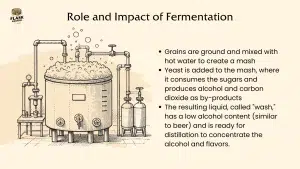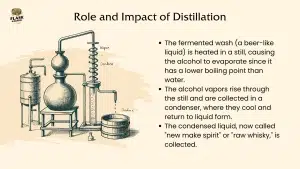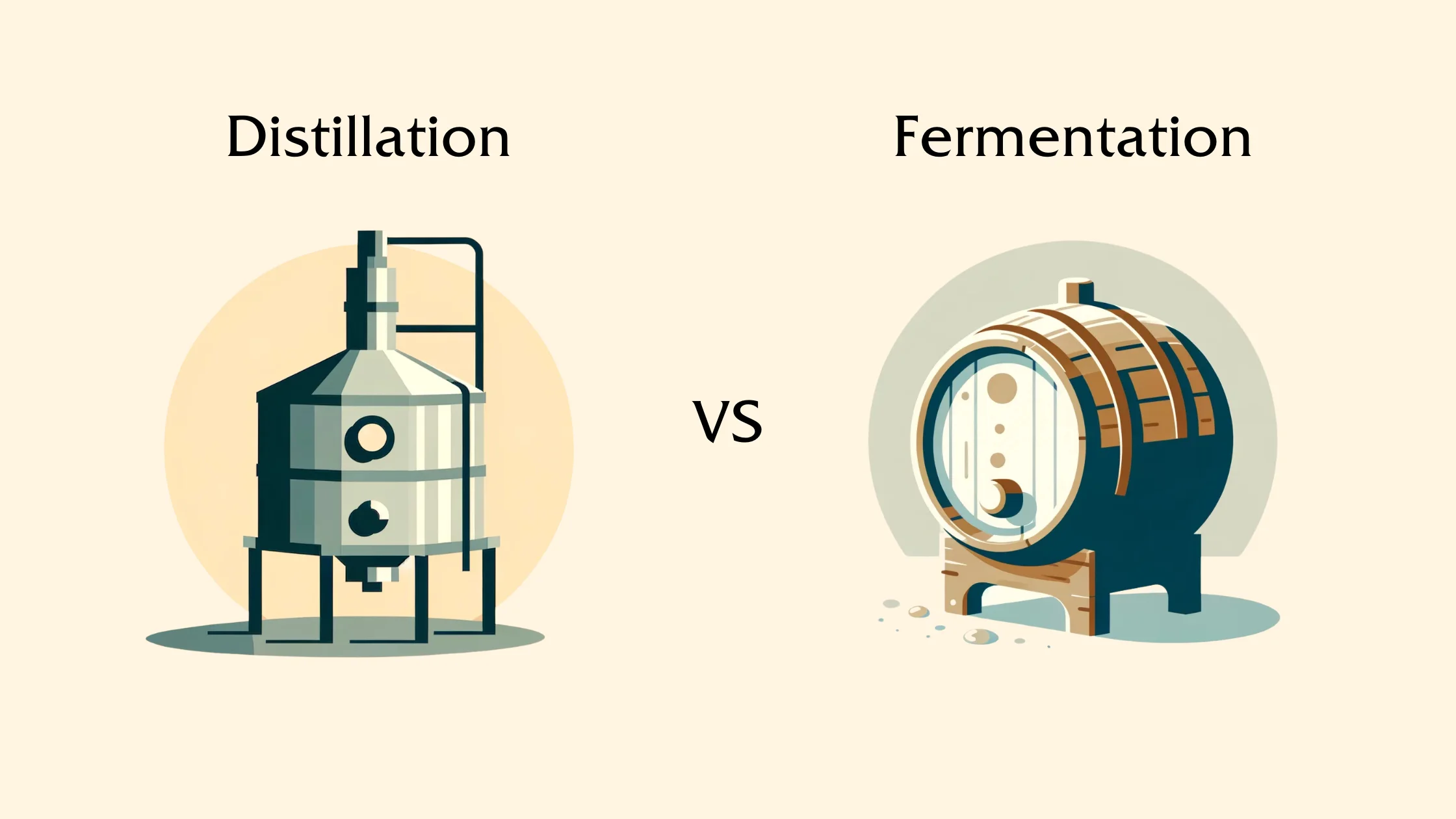In the art of whiskey production, fermentation and distillation are two key stages that shape the spirit’s final character.
Fermentation is the process where grain and yeast come together to create a liquid known as ‘wash.’ This liquid is a cocktail of alcohol and flavors extracted from the grains. The yeast acts as a catalyst, transforming the sugars in the grain into alcohol, and in the process, it releases carbon dioxide and heat.
On the flip side, distillation is a method used to elevate the alcohol content of the ‘wash’ produced during fermentation, while also refining its flavors. This process involves heating the wash, causing the alcohol and other volatile compounds to vaporize and then re-condense, resulting in a pure and concentrated spirit. The careful orchestration of fermentation and distillation allows whiskey manufacturers to produce a diverse range of finely crafted and uniquely flavored beverages.
Role and Impact of Fermentation
The fermentation process in whiskey production is a complex biochemical dance where yeast metabolizes the sugars in the grain mash, transforming them into alcohol. This process gives birth to the initial alcoholic beverage, the ‘wash.’ The role of fermentation in whiskey production is paramount as it is during this stage that the base flavor and aromatic compounds of the whiskey are formed.

The choice of yeast and the conditions under which fermentation occurs have a significant impact on the final flavor profile of the whiskey. Different yeast strains can yield varying flavors and aromas. Similarly, the temperature and duration of fermentation can influence these outcomes. For instance, higher temperatures or extended fermentation periods may lead to more fruity and ester-like flavors, while yeast strains that produce high alcohol levels can add warmth and depth to the whiskey.
The ‘wash’ resulting from fermentation usually has an alcohol content of approximately 6-8%, similar to beer, and carries all the primary flavors extracted from the grain. This ‘wash’ then moves on to the distillation stage for further refinement and concentration.
The Refinement Role of Distillation
Distillation is the subsequent step in whiskey production, following fermentation. This physical process heats the fermented mixture, or wash, to separate alcohol from other components based on their varying boiling points.
Distillation serves a dual purpose: it not only amplifies the alcohol content of the liquid but also refines and intensifies the flavors. As the wash is heated in a copper pot still, volatile compounds ascend with the ethanol vapors and are later condensed back into a liquid. This process purifies the spirit and alters its flavor profile.

Whiskey distillation typically involves two stages: the initial distillation, also known as the stripping run, which primarily concentrates on alcohol concentration, and the subsequent distillation, or spirit run, which further refines the spirit’s flavor and purity. The master distiller’s expertise is crucial in determining the cut points – the precise moments to separate the head, heart, and tail of the distillate, each harboring unique flavor and aroma compounds.
The resulting spirit from distillation is a clear, high proof liquid, typically ranging from 60-70% alcohol by volume (ABV). This potent spirit, often referred to as ‘new make’ or ‘white dog’, is then prepared for the aging process where it acquires color, additional flavors, and mellows over time.
Distinguishing Between Fermentation and Distillation
Fermentation and distillation are both vital to whiskey production, yet they perform different functions and take place at distinct stages of the production process.
Fermentation is a biological process where yeast transforms sugars into alcohol over several days. This step is fundamental as it creates the initial alcoholic substance known as the ‘wash’. On the other hand, distillation is a physical process that succeeds fermentation. During distillation, the alcoholic content of the ‘wash’ is amplified, and the flavors are further refined through the application of heat and cooling.
In simple terms, fermentation is the birth of whiskey, converting grains into a rudimentary alcoholic beverage. Distillation, however, refines and elevates this crude product into a more sophisticated spirit. It’s crucial to recognize that while fermentation always precedes distillation in whiskey production, both processes significantly shape the final character and quality of the whiskey.
Impact on Whiskey’s Flavor Profile
Whiskey, a spirit celebrated for its depth and complexity, derives its unique flavor profile from the intricate dance between fermentation and distillation. These two processes, each with its own distinct role, work in harmony to create the final taste, aroma, and subtleties that define each bottle of whiskey.
The journey of whiskey’s flavor begins with fermentation. The choice of grain, the yeast strains employed, and the duration of fermentation all play pivotal roles in shaping the primary flavor elements. This process results in the creation of ethanol and flavor-rich congeners, which lay the foundation of the whiskey’s flavor spectrum.
Yet, the craft of whiskey-making extends beyond fermentation. The raw wash birthed from fermentation is then subjected to distillation, a process that refines and intensifies the flavors. The techniques used in distillation, such as the number of distillations and the cut points chosen, further sculpt the whiskey’s distinctive character.
In essence, fermentation and distillation are two halves of a whole, working together to create the final flavor profile of the whiskey. This delicate balance of alcohol, aroma, and taste results in each bottle of whiskey being a unique testament to the distiller’s craft.
Flavor Contributions from Fermentation
Fermentation is a critical stage in whiskey production where yeast feasts on the sugars present in the mash, producing alcohols and congeners. While alcohol forms the backbone of any spirit, it’s the congeners that add depth to the taste and aroma of whiskey. These congeners encompass a wide array of compounds, including higher alcohols, esters, phenols, acids, and aldehydes.
Esters, born from the union of alcohol and acid during fermentation, infuse the whiskey with fruity and floral notes. Higher alcohols, often lending bready or spicy undertones, also enhance the mouthfeel due to their density and viscosity. Phenols, on the other hand, can introduce a spectrum of flavors, from medicinal to smoky, depending on their specific type and concentration.
Aldehydes, capable of adding nutty, grassy, or even bitter notes, are typically formed during fermentation and mature over time to add to the complexity of the flavor. The selection of yeast and the conditions during fermentation can significantly steer the formation of these compounds, thereby setting the initial course for the whiskey’s taste and aroma.
Flavor Refinements from Distillation
Distillation is the process that refines, purifies, and intensifies the flavors established during fermentation. It separates the alcohol and its associated flavors from the fermented mixture by leveraging differences in boiling points. This concentrates the flavors and discards undesirable elements.
The distillation process is influenced by various factors. The dimensions of the still, the pace of distillation, and the cut points — the moments when the distiller switches from collecting ‘heads’, to ‘heart’, to ‘tails’— all contribute to the final flavor. The ‘heads’ are high in alcohol but also carry harsh flavors, while the ‘tails’ often bear heavy flavors that may not be desired in the spirit. The ‘heart’, however, is the most coveted part, carrying the finest taste and aroma characteristics. The distiller’s timing in making these cut points directly impacts the final flavor profile of the whiskey.
The distillation method also plays a pivotal role. Pot distillation may yield a robust and flavorful profile, while continuous or column distillation, typically used for grain whiskey, results in a lighter, purer spirit. In short, distillation is the critical refining step that transforms the raw fermented product into a whiskey with its distinctive character and taste.
Identifying Qualities from Fermentation and Distillation
Understanding the nuances of whiskey involves recognizing how fermentation and distillation shape its qualities. The color, aroma, flavors, and smoothness of whiskey are a blend of elements, with these two processes playing a significant role.
Fermentation sets the stage for the flavor spectrum, as yeast interacts with sugars to produce alcohol and a variety of congeners, establishing the initial character of the whiskey. Distillation then steps in to refine these flavors, discarding unwanted elements and accentuating desirable traits.
By grasping these qualities, you can more deeply appreciate the layers of craftsmanship and tradition that underpin each unique expression of whiskey. Whether it’s the rich, full-bodied profiles produced by pot stills or the lighter, subtly nuanced flavors developed through column stills, the art of whiskey making is a delicate balance between fermentation and distillation. Every sip of whiskey is a testament to the distillers’ artistry and skill.
Recognizing Fermentation Qualities
The art of identifying the qualities derived from fermentation lies in the ability to distinguish the foundational flavors in whiskey. These flavors form the bedrock upon which the whiskey’s character is built. Descriptors such as fruity, floral, nutty, spicy, or bready are often the direct result of fermentation by-products.
Consider the fruity and floral flavors that are often associated with esters. These compounds are formed during fermentation and can give rise to flavors reminiscent of apple, pear, or cherry. These flavors are indicative of specific esters such as ethyl hexanoate, ethyl butanoate, or ethyl decanoate, all of which are produced by yeast during fermentation.
Fermentation also gives rise to higher alcohols, or fusel alcohols, which contribute to the richer, more substantial flavors in whiskey. These flavors might be reminiscent of fresh dough, creamy almond, or spicy clove. Phenols, on the other hand, can introduce medicinal or smoky nuances to a whiskey’s flavor profile.
The next time you enjoy a glass of whiskey, take a moment to appreciate its foundational flavors. Can you discern a subtle hint of apple or pear? Maybe a touch of bready richness? These are the subtle signatures of the fermentation process at work.
Detecting Distillation Characteristics
Once the fermentation process has laid the foundation of flavors, distillation steps in to refine and purify them. The characteristics of distillation are most evident in the balance and intensity of flavors, as well as the overall smoothness and clarity of the whiskey.
Tasting whiskey goes beyond merely assessing its alcoholic strength. The true test lies in discerning the concentration and balance of flavors in the ‘heart cut’ — the most coveted section of the distillate. This balance is carefully crafted by expert distillers who shape the character of the whiskey through their precise control over the distillation process.
The method of distillation can also leave its mark on the whiskey. For instance, whiskeys with a distinct sharpness, robustness, and intensity often suggest a pot distillation origin. This method is commonly used in single malt or pot still whiskey production and results in spirits with depth and character. On the other hand, a lighter, cleaner taste could indicate the use of a column still, a method often employed for grain whiskeys and blended spirits.
As you savor your next glass of whiskey, try to identify the underlying distillation methods. Experience the delicate balance between strength and subtlety, the interplay of various notes. Each sip is a testament to the distiller’s craft.





